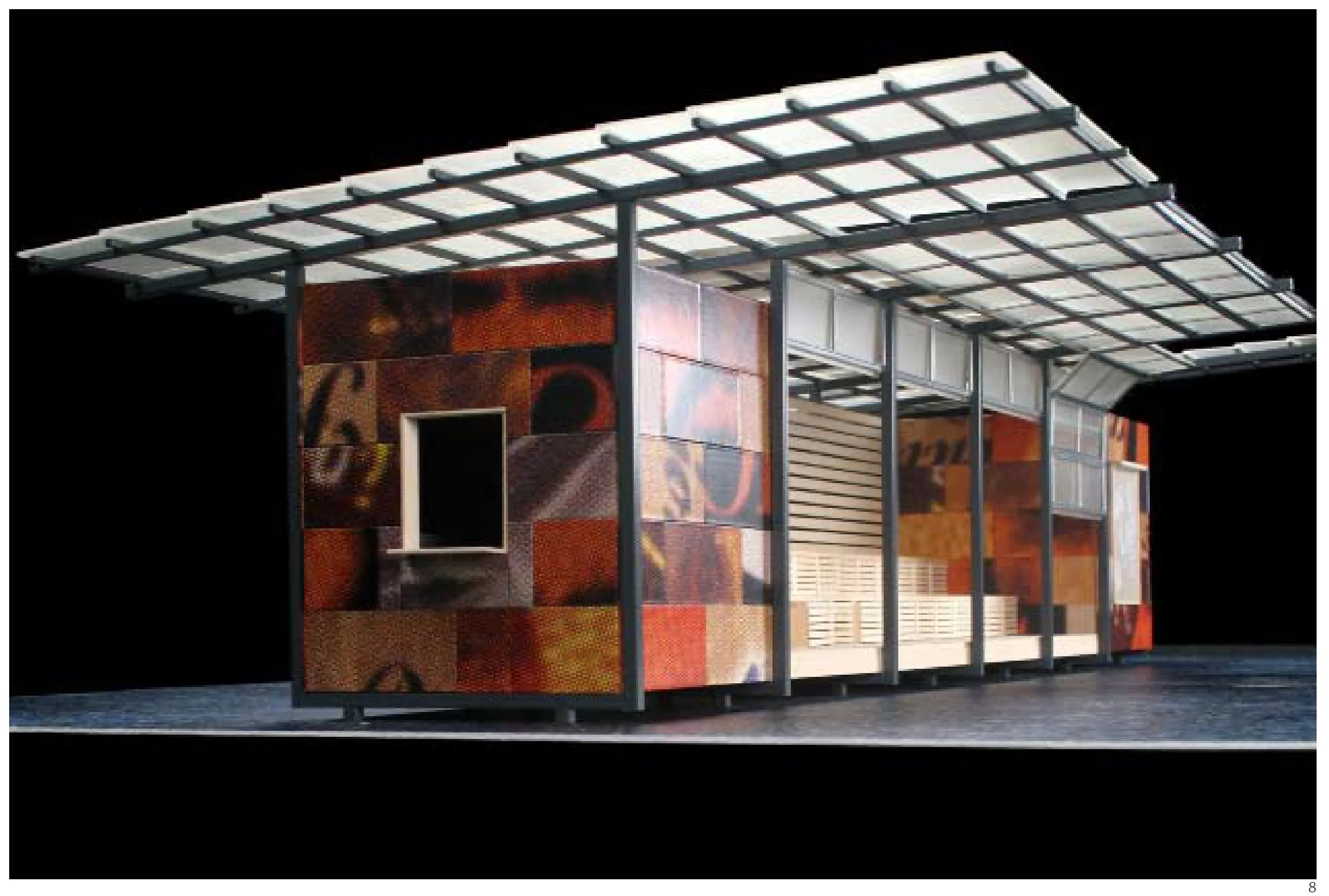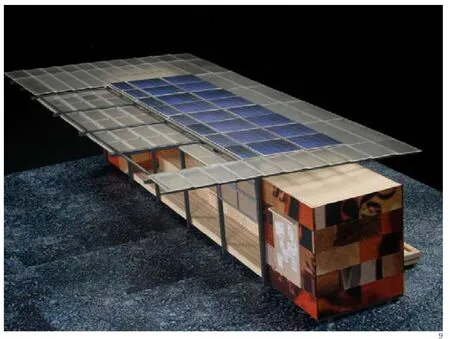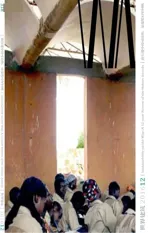第二届全球豪瑞奖创新奖:自给自足的临时工站,旧金山,美国
2016-12-21主要设计者利兹奥格布公共建筑工作室
主要设计者:利兹·奥格布/公共建筑工作室
第二届全球豪瑞奖创新奖:自给自足的临时工站,旧金山,美国
主要设计者:利兹·奥格布/公共建筑工作室

1 临时工站为临时工提供了特殊的场所,可供他们聚集并促进其就业/Te day labor station provides a specific place for day labor gatherings and facilitates the employment process
评委评语
这是一个通过最小限度的城市化物质干预达到最大限度的社会公平和社区改善效果的措施。该项目是以劳动力市场和服务交付平台为功能的小型构造,受众群体是那些每天在固定地点聚集等待临时工机会的临时工人。
Jury Appraisal
This is a minimal physical urbanistic intervention with maximum social equity and neighborhood enhancement effects. Te project is a small structure that functions as a labor market and service delivery platform for day laborers who wait for casual work every morning at customary gathering points.
设计团队/Design Team: Liz Ogbu/Public Architecture; John Peterson/Public Architecture + Peterson Architects
临时工的一天All in a Day's Work
在美国许多城市,临时工人利用街道角落作为非正式的雇工场所。他们在路边或者停车场一等等几个小时,通常是顶着烈日,也没什么便利设施可以利用。他们等雇主顺路雇佣他们工作一天,按天结算报酬。由敬业的建筑团队设计的自给自足式临时工站,旨在提高那些发现自己处于美国梦边缘的人们的生活质量。
在过去的几个小时内,5个墨西哥人坐在一个小运动场的台阶上。他们无精打采,只是偶尔交谈几句;他们眼睛看向远方,流露出无聊的神情。他们等待着,希望能有工作,也许要等一整天。他们就像在旧金山最著名的临时雇工场所塞萨尔·查韦斯街的数百名临时工一样。
在美国各地,像这样的临时工超过10万人。他们被雇佣刷墙、修整花园、搬家具或在建筑工地工作,时薪几美元。潜在的雇主在车内巡视,根据面孔选择他们觉得可以信任的临时工。也许他们会询问临时工的资历或经验。
这是一个非正式的体系,混杂了健康、安全和社区问题。
在就业市场没有机会
尽管通过竞争受雇很难,但临时工之间也少有愤怒的感觉。白天结束时,他们要花比工作更多的时间聚集在街道角落。然而,想和这5个墨西哥人谈话,也不容易。
理念是灵活的——临时工站可以改造成适合特定地点的实际情况
最年长的伊西多罗比他的同伴稍微亲切一点。他来旧金山已经有6年了——“最开始我在餐馆里工作,后面这个餐馆被卖掉了,我们都没了工作。”之后他一直寻找固定工作,但是无果。临时工是他唯一的选择。“有时候我一次性工作3天,但可能后面10天都没有工作,”他说。“你不可能知道明天会是什么样子,但你必须接受现实。”但没有工作的时候他怎么打发时间?“我就是坐在这里,有可能一直坐到下午。不然我还能做什么?”
提高在“避难城市”中的生活质量
据美国移民官员估计,自1990年代起,非法移民已经持续超过了合法移民。将近一半的非法移民通过签证来到美国,超过期限仍停留在美国。有一些是冒险穿越墨西哥和美国的边境来到美国。由于没有有效的文件,他们没有机会寻找合法的工作。许多人在非正式市场上寻找工作机会,仅仅是因为他们没有其他选择。
有些临时工称旧金山为避难所,是因为旧金山作为“避难城市”声名在外。美国的20个这类地方同样有名——他们的市政当局和警察不问个人的居住状况。生活的环境会更好一点,但还是不那么容易。如果被不守信用的雇主雇佣,可能他们付出了劳动,却得不到报酬。抢劫也很普遍——因为他们的报酬以现金方式结算,所以他们容易成为被抢劫对象。
“临时工计划”组织是一个非盈利组织,希望通过在全美建立100个官方中心来解决这些问题。这些中心旨在将工人与工作对接起来,让他们有固定的时薪,让他们的权益得到尊重。他们还提供教育计划——例如语言或电脑技能。但大多数临时工还是会拒绝到这些中心去——主要因为他们认为他们在街头可以有更好的选择,但也因为这会增加他们对他们生存状态的恐惧。
参与非盈利工作
公共建筑工作室启动了一项计划,设计了一项解决方案来提高那些希望停留在街头的临时工的生存环境。他们设计的自给自足式临时工站有灵活的结构、居所、洗手间、厨房和教育/培训空间。临时工站使用绿色和回收材料,以尽可能减小环境足迹以及降低各设施的成本。
位于旧金山市中心的公共建筑工作室,由约翰·彼得森创建于2002年。“我发现我想要在自己的建筑作品中有更多的平衡——之前主要为高档住宅项目,”他解释。“我想要在社区上制造更大的影响。”约翰·彼得森和他的团队构思出了旧金山一项公共空间项目的理念——这让不同机构之间进行对话。于是公共建筑工作室成立了。这让约翰·彼得森有了更多思考。
“我意识到,很少的建筑师参与非盈利工作,但是我们有很多可能来为社区做一些有意义的事情。” “1%计划”开始启动。“1%计划鼓励建筑和设计公司承诺至少用他们1%的时间来提供专业性的无偿工作”,他说,“我们是公司与需要设计援助的非盈利组织之间的协调者。”该计划正在发挥其预想的影响——在2005年,也就是该计划实施的第一年,相关公司提供了市场价值为200万美元的20,000小时工作。
找到问题
约翰·彼得森将公共建筑工作室形容为“建筑实践的新典范”。该工作室由基金、公司和个人捐款和补助金来维持运营,开展工作可以不受常规实践的经济限制。因而,公共建筑工作室可以为公共利益而工作。

2.3 2007年5-9月,全尺寸的临时工站的刻面在库珀-休伊特国家设计博物馆展出/A full scale section of the day labor station exhibited at the Cooper Hewitt National Design Museum, May-Sep 2007

4 组合图示/Component diagram

5 可持续图示/Sustainability diagram

6 使用图示/Use diagram

7 平面/Plan
“我们工作室是这样一个地方,建筑师可以找到问题,思考如何解决问题——而不是只对客户说的‘那样做’做出回应。”他说。例如,这个团队会注意怎么样进行创新设计来鼓励人们在公共区域的互动。“一个公交站不仅仅是公交站,”他说。“公交站是一个汇聚点,特别是在郊区,人们生活在相互隔离的空间。这是一个让他们与彼此接触的地方。”
几年前,约翰·彼得森参与移民社区工作的同时讨论了这个理念。“我们并没有为通勤一族设计公交站,而是为临时工站提出一种理念——临时工站是他们等待工作的庇护空间,也是休息室。”
创新和适应性
约翰·彼得森与利兹·奥格布一起设计了临时工站。利兹·奥格布出生在旧金山,在哈佛受过培训,通常认为建筑比物体设计更为深远。她通常与人类学家的父亲在家庭餐桌上讨论社会问题,这对她早年看待社会问题有潜移默化的影响。迄今为止,她所有的社会项目都有强烈的社会需求。另外,她的项目都可以被开发各种合适的原型,满足任何地方的社区的需要。“我喜欢创造有创新性和适应性的东西——它必须具有多样化和适应给定场所实际情况的潜力。”
利兹·奥格布在设计临时工站时也遵循了同样的开发程序。“首先,我们去与临时工讨论他们的需求”她说。“他们的业务模型非常简单,但是成功的——潜在的雇主到来,描述工作,与工人谈妥价格,将其带到工作现场。我们的设计需要考虑这个过程。”
临时工发现公共建筑工作室认真对待他们的想法时,他们感到很惊讶。“他们是我们的客户,但是他们没有受到这种待遇的经历。”她说。
他们描述的主要问题是没有取水途径或者在他们等待工作的时候没有便利设施。使用附近餐馆的便利设施是他们的唯一选择,他们也不愿意这样。在烈日下站几个小时让他们很虚弱。还有一个重点就是他们需要确保能与潜在雇主保持良好的眼神接触。“这就是工作的分配方式,”利兹·奥格布说。“临时工认为,视觉接触是良好雇佣过程的关键。”
灵活性和自给自足
建筑师设计的临时工站与他们最开始讨论的公交站非常类似。临时工坐在高木凳上,木凳上方有遮棚。木凳两端的小房间可以用来做厕所或厨房。厨房类似移动的食品摊贩,可以产生现金收入用来维持临时工站的运作。临时工站是自给自足型的。电由集成在顶棚中的光电模块产生。临时工站的设计尽量减小环境足迹,利用绿色建材来建造,例如回收的PVC砖、乙烯广告牌、纤维水泥板以及当地回收利用的木材。厨房能用回收的餐馆装置来安装。
其原型证实了其可适应任何情况的灵活性。“对
In many US cities day laborers use street corners as informal hiring sites. For hours on end they wait by the roadside and in parking lots, often in the hot sun and without any amenities. They wait for an employer to stop by and offer a day's work for a day's pay. The self-contained day labor station designed by a team of committed architects aims to improve the life quality of those who find themselves on the edge of the American Dream.
For the past few hours five Mexicans have sat on the steps in front of a small sports ground. Sapped of energy, they share only a few words; bored, they stare into the distance. And wait, perhaps the whole day, for work. As day laborers, they are like hundreds of others who wait around San Francisco's most famous informal hiring site, César Chávez Street.
Over a hundred thousand more are stretched across the USA. For a few dollars an hour, they are hired to paint walls, maintain gardens, move furniture, or work on building sites. Potential employers cruise by in their cars, check out the faces, and choose someone they think they can trust. Perhaps qualifications or experience are asked for.
It is an informal system presenting a myriad of health, safety, and community concerns.
No chance on the job market
Even though competition to get hired is tough, there is little sense of resentment between the laborers. At the end of the day, they spend more time together on a street corner than working. Engaging the five Mexicans in conversation, however, is difficult.
The concept is flexible – the day labor station can bealtered to fit the realities of a given location
Yet the eldest, Isidoro, is a little more forthcoming than his friends. He has been in San Francisco for the past six years –"At first I worked in a restaurant, but it was sold and we all lost our jobs." Since then he has searched for permanent work but to no avail. Day labor is his only option.
"Sometimes I have work for three days in a row, then maybe it's ten days of nothing," he says. "You never know what tomorrow brings, but you learn to accept it." But how does he spend his time when there is no work? "I just sit here, perhaps till the afternoon. What else can I do?"
Better life in "sanctuary cities"
US-Immigration officials estimate that illegal immigration has continued to outpace the level of legal immigration since the 1990s. Almost half of all illegal immi-grants arrive on a visa but overstay its expiry. Others risk crossing the border between Mexico and the USA. Without valid papers, there is no chance of legal work. Many find themselves on the informal market just because there is no other option.
The day laborers who call San Francisco home do so because of its reputation as a "sanctuary city". Around 20 locations in the USA are similarly known – their town hall authorities and police force ask no questions about a person's residency status. Life is better but it certainly isn't easy. If employed by disreputable contractors, perhaps they are not paid for their labor. Robbery is common – paid in cash, they make an easy target.
The Day Labor Program, a non-profit organization, tries to address these issues via their 100 official centers established across the country. The centers aim to connect workers with jobs, at a fixed hourly rate, and with their rights respected. They also offer education programs – language or computer skills, for example. Yet most day laborers avoid the centers – mainly because they believe they have a better chance on the street, but also because it raises fears about their status.
Engaging non-profit work
Thanks to an initiative by architectural studio Public Architecture, a solution to improve the situation of day laborers who want to stay on the streets has been developed. Their self-contained day labor station offers flexible structures, shelter, benches, wash-rooms, a kitchen and an education/ training space. Green and recycled materials are used to minimize the environmental footprint and economic cost of each facility.
The studio of Public Architecture based in the center of San Francisco was established by John Peterson in 2002. "I found myself wanting more balance in my architectural work – up until then it was mainly high-end residential projects," he explains. "I wanted to make a bigger impact on the com-munity." Together with his team, ideas for a public space project in San Francisco were sketched – it led to conversations with different agencies. Public Architecture was founded. It also led John Peterson to do some more thinking.
"I realized that few architects engage in nonprofit work, but there is an enormous potential for us to contribute something worthwhile to the community." Te 1% Program sprang to life. "Te 1% Program challenges architecture and design firms to pledge a minimum of 1% of their time to pro bono service," he says. "We act as a facilitator to connect firms with the non-profit organizations who need design assistance." Te program is having its desired impact – in 2005, its first year, 20,000 work hours with a market value of 2 million USD were offered.
Identifying problems
John Peterson describes Public Architecture as "a new model for an architectural practice." Supported by foundations, corporate and individual donations and grants, the studio can work outside the economic constraints which apply to conventional practices. Public Architecture therefore can work for the public good.
"We're a venue where architects can identify problems and think about how to solve them – not just respond to a client who says: 'Make that!'," he says. As an example, the team looks at how innovative design can encourage people's interactions in public areas. "A bus stop is not just a bus stop," he says. "It's a meeting point, especially in the suburbs where people exist in detached isolation. It's a place to engage with others."
Several years ago John Peterson discussed this idea with a colleague who was involved with the migrant community. "Instead of a bus station for commuters, we began to develop ideas for a day labor station – a sheltered space for them to wait for work, as well as a restroom."
Liz Ogbu quickly developed a strong relationship withher day laborer clients – a big advantage in the project.
Innovative and adaptable
John Peterson designed the day labor station together with Liz Ogbu. Born in San Francisco, and trained at Harvard, Liz Ogbu has always seen architecture as more than the design of an object. With her father, an anthropologist, discussions around the family dinner table informed her opinions about social issues early. All her projects to date have fulfilled a strong societal need. Further, they are developed as prototypes which can be adapted to the needs of communities anywhere. "I like to create something that is both innovative and adaptable – it must have potential to be multiplied and fit the realities of a given location."
For the day labor station, Liz Ogbu followed the same developmental process. "First we went and talked with day laborers about their needs," she says. "Their business model is very simple, but successful – a potential employer arrives, describes the job, agrees a price with the laborer and takes him to the site. Our design needed to take account于厕所,我们有多种可能性。”利兹·奥格布说。“在有些地方,它甚至可用作露营厕所。”经过些微改动,工作站可以转化为一个教室。因为大多数工作在上午9点分配,剩下的人有机会使用其空闲时间来学习志愿组织提供的课程。
社会和美学
临时工站满足最基本的社会需求。但是建筑师在设计时也考虑了美学方面。“公共建筑工作室团队在这些事情方面密切合作,”利兹·奥格布说。“工人把雇工场所看得很神圣——我们的结构应反映出这种情感。” 约翰·彼得森补充道:“我们旨在回答这个问题:我们如何才能设计出解决真实社会需求的美丽事物。设计的力量不应该被低估——它证明了我们非常重视我们的客户,不管他们处于什么样的社会阶层。”
确实,临时工生活在社会边缘。临时工站的理念制造了一个满足临时工日常需求的敏感性生活环境。另外,临时工站的结构为扩展计划提供了物理位置,而且加强了临时工之间的社会凝聚力。临时工站让他们有时候在面对来自社会的敌意时会更有尊严地出现在社会领域中。最后,临时工站不仅仅是一个临时工站。就像公交站不仅仅是一个公交站。它是一个为社会阶层中临时工群体进行辩护的机会。
为了证明他们对项目的敬业,希望临时工会自己建造他们的临时工站。这也能将成本降到最低,成本本身由国家、捐款或非盈利组织提供——“难以找到成本不太高的好方案,”利兹·奥格布说。如果不建造地基或太阳能收集装置,单个成本大约为10万美元。
愿意为提高生活水平而工作
尽管作为原型建造,但有些希望尝试实践该理念的城市仍在展开讨论。从城市的角度来看,其改善临时工以及更大的社区的健康和安全状况的潜力很大。“非正式场所容易引起争议。”利兹·奥格布解释。“超过3/4的场地占用其它用途的空间,例如家装店停车场。”
她看到的反差就是,临时工认同美国核心价值观,尽管他们在美国大部分都是非法状态。“他们在这里是为了让他们自己和孩子获得更好的生活——他们愿意为这个目的工作!”
“从长远来看,政治在全国各地临时工站是否布置为非正式场所中发挥关键作用。”利兹·奥格布说。“作为建筑师,我们有机会和责任促进关于这类问题的对话。”她补充道,“没有全局的视角,我们如何能创造出更好的世界?”of this process."


8.9 模型/Model views
Yet, the day laborers were amazed when Public Architecture took their ideas seriously. "They were our clients, but had no experience at being treated as such," she says.
The main problems they described were no access to water or amenities during their sometimes long wait for a job. Using amenities in nearby restaurants was their only choice, which generated ill will. Standing in the sun for hours was debilitating. A further point was the need to ensure they had good eye contact with the potential employer. "Tat is how jobs are allocated," Liz Ogbu says. "Visual contact is key to a worker's perception of a fair hiring process."
Flexible and self-sufficient
The station the architects designed was very similar to the bus station of their original discussion. The day laborers sit on raised wooden benches under a canopy roof. At each end boxes can be attached for use as toilet or kitchen – the latter, similar to a mobile food vendor, could generate funds to support maintenance. The station is selfsufficient. Electricity comes from photovoltaic modules integrated into the canopy. Designed to make a minimal footprint, it utilizes green materials such as recycled PVC tiles, billboard vinyl, fiber cement panels and locally sourced, salvaged or recycled timber. Te kitchen can be fitted out with recycled restaurant appliances.
The prototype demonstrates its flexibility to be adapted to any situation. "For the toilet, we have various possibilities," Liz Ogbu says. "In some places it could even be a camper- toilet." With few modifications, the station could be converted into a classroom. As most jobs are assigned by nine in the morning, for the remainder there is the opportunity to use their free time for learning programs that support organizations offer.
Social and aesthetic
The station amply meets the social requirements of the brief. But it is designed with aesthetics in mind as well. "For the team at Public Architecture, these things go hand-in-hand," Liz Ogbu says. "Workers view their hiring sites as sacred – our structure should reflect that." John Peterson adds: "We aim to answer the question: how can we design something of beauty that solves a genuine social need. The strength in design shouldn't be underestimated – it demonstrates we value our clients highly, no matter what strata of society they occupy."
Flexible Solutions: Because community needs vary, the station is designed as a kit of parts to be altered to fit the realities of a given location. The specificity in each context is determined through discussions and coordination with the diverse stakeholders at each project location.
Indeed day laborers live on society's periphery. The station concept creates a sensitive living environment which meets their daily needs. In addition the structure provides a physical location for outreach programs and enhances social cohesion amongst the laborers themselves. It provides them with a more dignified presence in the public realm, in the face of, at times, community hostility. In the end, the day labor station is not just a station. Just as a bus stop is not just a bus stop. It is an opportunity for advocacy about the role of day laborers in the fabric of society.
Demonstrating their commitment to the project, the hope is that day laborers will selfbuild their stations. This is also to keep costs to a minimum, which would need to be covered by the state, donations or non-profit organizations –"it is difficult to find a good solution that isn't too expensive," Liz Ogbu says. Without foundations or solar collectors, the cost per unit is around USD 100,000.
Willing to work for a better life
Although built as a prototype, discussions are ongoing with several cities which are eager to trial the concept. From a city's perspective, its potential for improving health and security for day laborers as well as the broader community is high. "Te informal sites are controversial," Liz Ogbu explains. "Over three quarters of the sites occupy spaces meant for other uses such as home improvement store parking lots."
Te irony she sees is that day laborers echo core American values, despite their mostly illegal status in the country. "Tey are here to get a better life for themselves and their children – and they're willing to work for it!"
In the long run, politics will play a significant role in whether day labor stations are deployed as informal hiring sites across the country or not", Liz Ogbu says. "As architects, we have an opportunity and a responsibility to advance conversations on issues such as this," she adds. "Without a holistic vision, how can we create a better world?"
2nd Global Holcim Awards Innovation Prize: Self-contained Day Labor Station, San Francisco, USA
Main Author: Liz Ogbu/Public Architecture
